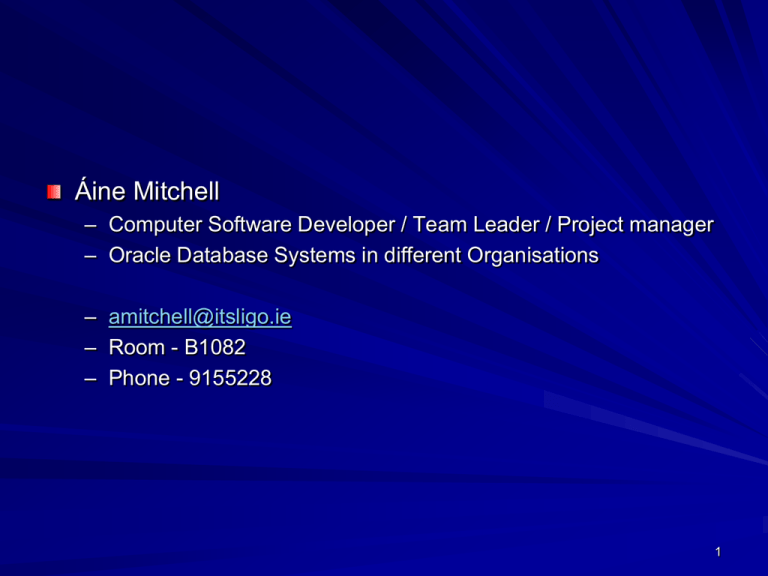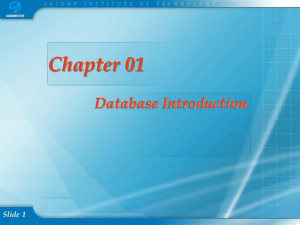Database
advertisement

Áine Mitchell – Computer Software Developer / Team Leader / Project manager – Oracle Database Systems in different Organisations – amitchell@itsligo.ie – Room - B1082 – Phone - 9155228 1 Data Management Introduction 2 Data Management What is Database and its Purpose What types of Data Company needs to store Data as a resource DBMS – Features and Advantages Functionality of DBMS Issues with Data Management Centralised Data Management 3 Traditional File Systems All automated systems which use data must store this data somewhere. Traditionally this data was stored in files. Each program or application had its own files in its own format It was difficult to integrate data from different systems. The data and the program were tightly coupled, so if one changed the other had to change also. – E.g. changing to 8 digit phone numbers. 4 Purpose of Database Businesses of every size organize data records into collections called databases. Small businesses for example use databases to keep track of customers Huge corporations such as Dell and Amazon.com use databases to support complex sales, marketing, and operations activities 5 Huge Quantities of Data Modern systems produce huge amounts of data. – EPOS system. – Web retail site – Decision Support Systems – ERP Systems– Enterprise Resource Planning HR, Financials,Distribution,Product LifeCycle Customer Relationship Management CRM Supply Chain – Purchasing, Manufacturing, Distribution Commercial Applications Manufacturing Engineering, bills of material, scheduling, capacity, workflow management, quality control, cost management, manufacturing process, manufacturing projects, manufacturing flow Supply chain management Order to cash, inventory, order entry, purchasing, product configurator, supply chain planning, supplier scheduling, inspection of goods, Financials Claim processing, commission calculation Financials General ledger, cash management, accounts payable, accounts receivable, fixed assets Commercial Applications Project management Costing, billing, time and expense, performance units, activity management Human resources Human resources, payroll, training, time and attendance, roistering, benefits Customer relationship management Sales and marketing, commissions, service, customer contact and call center support Data services Various "self-service" interfaces for customers, suppliers, and/or employees Access control Management of user privileges for various processes 8 Data Requirements ? HSE City and Guild of London Institute Company that Manufactures Paper Product Bórd Na Mona Mulit- National Computer Company College 9 Physical and Logical Data Logical View – Is concerned with the nature of the data or information – Logical view of a record is a set of data items filling the structure Physical View – Involves physical aspects of the storage and presentation – How the Data is store, e.g. Employee # char(6) 10 Data as a Resource Organisation need to collect and manage data to ensure that it can be accessed and used by people across the organisation. – Handle transactions – Legal reasons – Analyse, understand and improve their business. – Possible to gain a competitive advantage What Is the Purpose of a Database? Purpose: to keep track of things If structure of a list is simple, i.e., one theme, no need to use database technology (video) Form for Recording Multiple Themes Database Based System Rather than storing data in file systems store it in data bases which can be accessed by a variety of applications. There are rules describing what kind of data is stored and how it can be accessed and changed. The data is independent of the applications. 14 Database Database: A self-describing collection of integrated records In databases, bytes are grouped into columns, such as Student Number and Student Name. Columns are also called fields. Columns or fields, in turn, are grouped into rows, which are also called records. Database A Database is an organised collection of related data. There are lots and lots of different ways to organise data Ideal method to organise data would combine complete flexibility with complete control. 16 Hierarchy of Data Characters, Fields, and Records Hierarchy of Data Elements Database is collection of Table or Files Components of a Database Application System Applications make database data more accessible and useful. Users employ a database application that consists of forms, formatted reports, queries, and application programs. Database management system (DBMS) processes database tables for applications. DBMS DataBase Management System A Database with Software for the following: – Database definition Specify the content and structure. – – – – – – Data entry and modification. Data processing and report generation. Provides an interface to user programs (e.g. SQL). Security. Recovery Centralized Control over the Data 20 DBMS Products DB2 (from IBM) MySQL (a free, open source DBMS) Oracle (from Oracle Corporation) SQL Server (from Microsoft) ASE (from Sybase Corporation) Access (from Microsoft) 21 Advantages of using a DBMS Separates the data from the programmes using the data. Reduces data redundancy and inconsistency. Reduces costs of developing new applications. Improves the flexibility of the information systems Security can be improved 22 Desired functionality in a DBMS What do you want from your data management system? – Database Definition – Data Access – Data Management 23 Database Definition Need to be able to define the database structure and the contents. What records can be stored. What fields there are. What the relationship between the records is. 24 Data Access Inserting new data Searching for data Generating reports Updating data already stored. Deleting data. 25 Data Access Speed of Access Depending on the application the database may be organised so updating is quick or so that searching is quick. Data may be indexed to allow speedy access. Security of Access Need to ensure that access to data is limited to authorised users only. May have different access levels so users can search but not insert data etc. 26 Issues in Data Management Concurrency: – Allowing multiple users to work on the database simultaneously. Not necessary in a single user system. Transactions – Allowing multiple records to be changed instantaneously e.g. transfer of funds between two accounts. – Need to ensure that if there is a problem during the transaction the database reverts to the original state and that no one else can interfere with any of the records during the transaction. 27 Issues in Data Management continued Recovery – Surviving application and system crashes Copying of data. – Ideally the database system should be able to import data from other sources, and to export it for use elsewhere. – Need some way to back up databases and to restore in the event of a system failure that damages the database. – hot backups is the term used when users can back up databases while they are in use. Needed for applications which must run without interruption, and cannot be shut down for backups. 28 Defining the database structure The choice of DBMS will influence how the data is organised. It is important when defining the database structure that the current and possible future needs of the organisation are taken into account. 29 Centralised Data Management Organisations may have data stored by different applications. – E.g. college may have student data in many different locations. Problems can still arise if there is no single standard format for data. – Cannot integrate the data from different databases. Examples – Field names may be different. – Field contents may be different. – Fields may be missing. 30 Centralised Data Management May be appropriate to have a single company wide data standard. – However there can also be problems with this. It can be very difficult to agree on the single standard. Can lead to bureaucracy and lack of flexibility. 31 Conclusion Keeping data in databases is better than keeping it in file systems. Data needs be managed. 32









